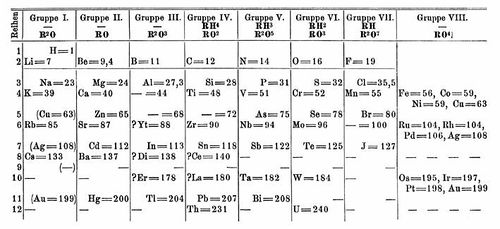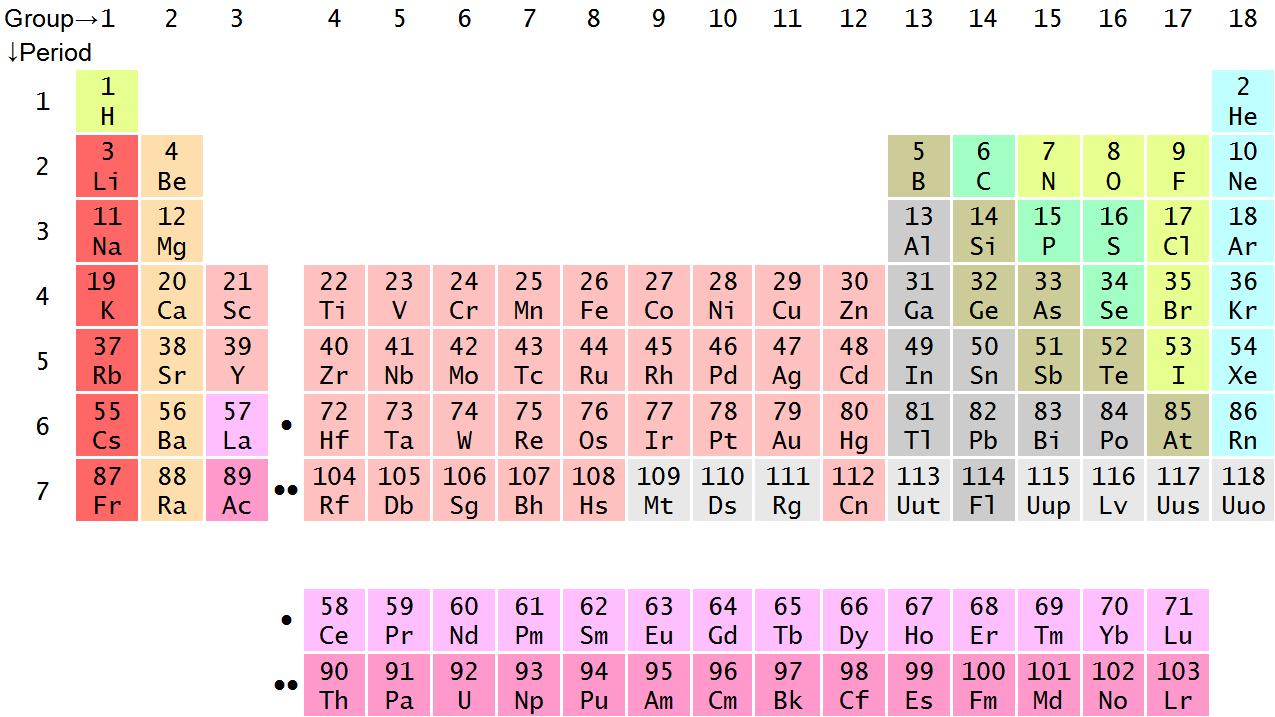4.3: The Periodic Table
- Page ID
- 49301
The similarities among macroscopic properties within each of the chemical families just described lead one to expect microscopic similarities as well. Atoms of sodium ought to be similar in some way to atoms of lithium, potassium, and the other alkali metals. This could account for the related chemical reactivities and analogous compounds of these elements.
According to Dalton’s atomic theory, different kinds of atoms may be distinguished by their relative masses (atomic weights). Therefore it seems reasonable to expect some correlation between this microscopic property and macroscopic chemical behavior. You can see that such a relationship exists by listing symbols for the first dozen elements in order of increasing relative mass. Obtaining atomic weights, we have

Elements which belong to families we have already discussed are indicated by shading around their symbols. The second, third, and forth elements on the list (He, Li, and Be) are a noble gas, an alkali metal, and an alkaline-earth metal, respectively. Exactly the same sequence is repeated eight elements later (Ne, Na, and Mg), but this time a halogen (F) precedes the noble gas. If a list were made of all elements, we would find the sequence halogen, noble gas, alkali metal, and alkaline-earth metal several more times.
In 1871 the Russian chemist Dmitri Ivanovich Mendeleev (1834 to 1907) proposed the periodic law. This law states that when the elements are listed in order of increasing atomic weights, their properties vary periodically. That is, similar elements do not have similar atomic weights. Rather, as we go down a list of elements in order of atomic weights, corresponding properties are observed at regular intervals. To emphasize this periodic repetition of similar properties, Mendeleev arranged the symbols and atomic weights of the elements in the table shown below. Each vertical column of this periodic table contains a group or family of related elements. The alkali metals are in group I (Gruppe I), alkaline earths in group II, chalcogens in group VI, and halogens in group VII. Mendeleev was not quite sure where to put the coinage metals, and so they appear twice. Each time, however, copper, silver, and gold are arranged in a vertical column. The noble gases were discovered nearly a quarter century after Mendeleev’s first periodic table was published, but they, too, fit the periodic arrangement. In constructing his table, Mendeleev found that sometimes there were not enough elements to fill all the available spaces in each horizontal row or period. When this was true, he assumed that eventually someone would discover the element or elements needed to complete a period. Mendeleev therefore left blank spaces for undiscovered elements and predicted their properties by averaging the characteristics of other elements in the same group.

As an example of this process, look at the fourth numbered row (Reihen). Scandium (Sc) was unknown in 1872; so titanium (Ti) followed calcium (Ca) in order of atomic weights. This would have placed titanium below boron (B) in group III, but Mendeleev knew that the most common oxide of titanium, TiO2, had a formula similar to an oxide of carbon CO2, rather than of boron, B2O3. Therefore he placed titanium below carbon in group IV. He proposed that an undiscovered element, ekaboron, would eventually be found to fit below boron. (The prefix eka means “below.”) Properties predicted for ekaboron are shown in the following table. They agreed remarkably with those measured experimentally for scandium when it was discovered 7 years later. This agreement was convincing evidence that a periodic table is a good way to summarize a great many macroscopic, experimental facts. Table \(\PageIndex{1}\) Comparison of Mendeleev’s Predictions with the Observed Properties of the Element Scandium.
| Properties Predicted for Ekaboron (Eb)* by Mendeleev 1872 | Properties Found for Scandium after its Discovery in 1879 | |
|---|---|---|
| Atomic weight | 44 | 44† |
| Formula of oxide | Eb2O3 | Sc2O3 |
| Density of oxide | 3.5 | 3.86 |
| Acidity of oxide | Greater than MgO | Greater than MgO |
| Formula of chloride | EbCl3 | ScCl3 |
| Color of compounds | Colorless | Colorless |
* Mendeleev used the name ''eka''boron because the blank space into which the element should fit was ''below'' boron in his periodic table.
† The modern value of the atomic weight of scandium is 44.96.
The modern periodic table differs in some ways from Mendeleev’s original version. It contains more than 40 additional elements, and its rows are longer instead of being squeezed under one another in staggered columns. For example, Mendeleev’s fourth and fifth rows are both contained in the fourth period of the modern table. This ends up placing gallium, not scandium underneath boron in the periodic table. This rearrangement is due to theory on the electronic structure of atoms, in particular ideas about orbitals and the relation of electronic configuration to the periodic table. The extremely important idea of vertical groups of related elements is still retained, as are Mendeleev’s group numbers. The latter appear as roman numerals at the top of each column in the modern table.
To end on a very practical note, there are a variety of sites with interactive periodic tables listed below. These tables can be helpful for understanding periodic trends and learning cool facts about the elements themselves.
Periodic Table [www.ptable.com]
Periodic Table [www.rsc.org]
Periodic Table of Elements [www.webelements.com]



